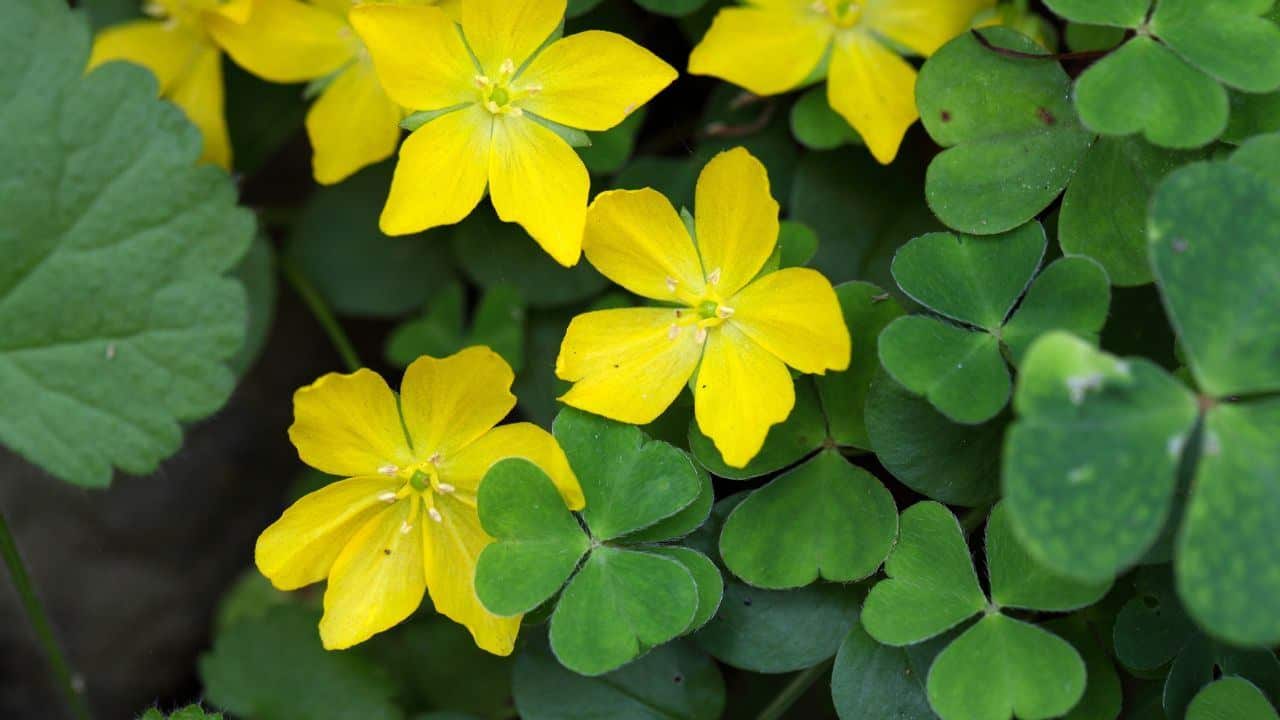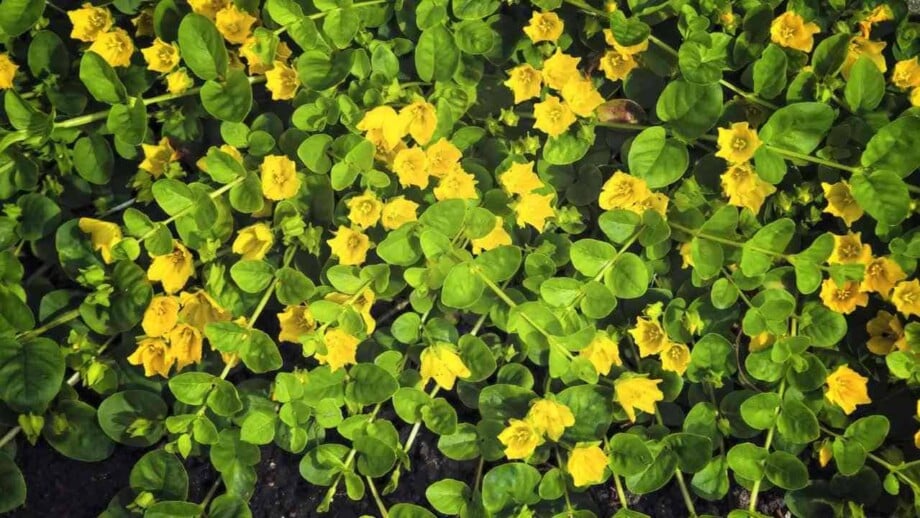If you’re looking for a low-maintenance, yet visually stunning plant to add to your garden or indoor collection, the creeping jenny is an excellent choice. This vibrant plant is known for its bright yellow color and trailing growth habit.
Creeping jenny, also known as Lysimachia nummularia, is a low-growing, creeping plant that is perfect for ground cover. It is a hardy plant that can thrive in a variety of conditions, making it a popular choice for gardeners. Single, bright yellow cup-shaped flowers also occasionally appear in the leaf axils adding to its beauty.
It’s often thought of as a nuisance in the yard because of its ability to spread quickly, but that’s also what makes it look stunning in the yard. With some handy tips, you’ll be able to grow this stunning perennial ground cover in no time, making it a great option for both beginner and experienced gardeners alike.
In this guide, I’ll walk you through everything you need to know about how to plant, grow, and care for Creeping Jenny.
Botanical Name: Lysimachia nummularia
Common Name: Creeping Jenny, moneywort, herb twopence, twopenny grass
Family: Primulaceae family
Plant Type: Perennial ground cover
Hardiness Zones: 4 – 9 (USDA)
Sun Exposure: Full sun
Soil Type: Well-draining sandy, loamy, or clay
Soil pH: Acid, alkaline, neutral
Size: 2 – 4 inches tall
Bloom Time: Summer
Flower Color: Yellow
Native Area: Western Asia and Europe

Creeping Jenny Plant Care
Creeping Jenny is a beautiful perennial that can add a pop of color to any garden or home. With proper care and attention, this plant can thrive and provide years of enjoyment. It features bright, small yellow flowers which don’t bloom for too long but look stunning. It makes for an excellent ground cover and is known best for its foliage.
You can use golden creeping jenny as a spiller plant or a trailing plant in pots, containers, hanging baskets, window boxes, or consider using it near water features! Ponds and water gardens are ideal places to use this stunning perennial ground cover.
It’s important to note that creeping jenny is considered an invasive plant in some areas thanks to its ability to establish itself quickly and grow like wildfire. It was first introduced in the US as ornamentals and ground covers but now grow in the wild in many areas including swamps, ditches, marshes, and roadsides.
It looks beautiful when planted with other shade-loving plants like ferns, hostas, and impatiens. It also pairs well with other trailing plants like sweet potato vine and ivy. When choosing companion plants, look for those with similar light and water requirements to ensure that they thrive together.
Light
Creeping jenny thrives in bright, filtered sunlight, but it can also tolerate partial shade. Avoid exposing this plant to direct sunlight for prolonged periods, as this can cause leaf burn. If you notice your plant beginning to wilt or brown, adjust its exposure to light accordingly.
Soil
Creeping jenny prefers moist, well-draining soil that is rich in organic matter. It can tolerate a wide range of soil pH levels, but it grows best in slightly acidic to neutral soil.
Before planting your creeping jenny, amend the soil with compost or other organic matter to ensure good drainage and fertility.
Water
Watering is a critical part of creeping jenny care, as this plant requires consistent moisture to thrive. That being said, avoid overwatering or allowing the soil to become waterlogged, as this can lead to root rot.
Water your creeping jenny regularly, keeping an eye on the soil moisture level and adjusting your watering schedule as needed.
Temperature and Humidity
Creeping jenny is a hardy plant that can tolerate a range of temperature and humidity levels. However, it prefers moderate temperatures and humidity levels.
If you live in a particularly dry or hot climate, consider misting your plant regularly or placing it near a humidifier to maintain the ideal growing conditions.
Fertilizer
While creeping jenny does not require frequent fertilization, it can benefit from occasional applications of slow-release fertilizer during the growing season.
Apply fertilizer according to package instructions, and be careful not to over-fertilize, as this can lead to excessive growth and reduced plant health.
Pruning
Pruning is an important part of creeping jenny care, as it helps to maintain the plant’s shape and prevent overgrowth. Trim your plant regularly, removing any dead or damaged foliage and shaping the plant as desired.
Creeping jenny is also an excellent candidate for propagation, so don’t be afraid to use your trimmings to start new plants!

Common Types of Creeping Jenny
Creeping Jenny, also known as Lysimachia nummularia, is a versatile plant with several cultivars and variations. Here are some popular varieties:
- Lysimachia nummularia: This is the standard variety, often referred to as Creeping Jenny or Moneywort. It features round, vibrant green leaves that form dense mats of foliage. It thrives in moist soil and can be used as ground cover or in hanging baskets.
- Lysimachia ‘Goldilocks’: Goldilocks is a cultivar of Creeping Jenny known for its striking golden-yellow foliage. The leaves are small and rounded, creating a beautiful contrast against other plants. This variety prefers partial shade and moist soil, adding a bright touch to gardens and containers.
- Lysimachia ‘Aurea’: ‘Aurea’ is another cultivar of Creeping Jenny that exhibits golden foliage. It has slightly larger leaves than the ‘Goldilocks’ variety and creates a vivid carpet of chartreuse to yellow-green. This variety is an excellent choice for brightening up shady areas and moist landscapes. It’s also less invasive than the green variety.
- Lysimachia ‘Golden Globes’: ‘Golden Globes’ is a unique form of Creeping Jenny distinguished by its rounded, globular growth habit. It has bright yellow leaves that resemble tiny golden spheres, creating a delightful and eye-catching display. This variety is well-suited for borders, rock gardens, or as an accent plant in containers. Use it as a perennial groundcover or a flowerin annual.
How to Propagate Creeping Jenny
Propagating your creeping jenny plant is not only easy but also really rewarding. Here’s how to easily do it at home:
Choosing the Right Stem Cuttings
When selecting stem cuttings for propagation, it is important to choose healthy stems that are free from disease and pests. Look for stems that are firm and green, and avoid any that are wilted or discolored.
You can take stem cuttings from the main plant at any time of year, but it is best to do so in the spring or summer when the plant is actively growing.
Preparing the Soil
Before rooting your stem cuttings, you will need to prepare the soil. Creeping jenny prefers moist, well-draining soil, so choose a potting mix that is designed for this type of plant.
You can also add some perlite or sand to the soil to improve drainage. Fill a small container with the soil, leaving about an inch of space at the top.
Rooting the Stem Cuttings
To root your stem cuttings, simply remove the leaves from the bottom few inches of the stem, and dip the cut end into rooting hormone.
This will help to encourage the stem to grow roots. Insert the stem into the soil, burying it about an inch deep, and gently press the soil around it to hold it in place.
Caring for Your New Plants
Once you have rooted your stem cuttings, it is important to care for them properly. Keep the soil consistently moist, but not waterlogged, and provide moderate light.
Avoid placing the plants in direct sunlight, as this can cause them to dry out. Within a few weeks, you should see new growth appearing, indicating that the plant has successfully rooted.
Creeping jenny is a beautiful and versatile plant that can add color and texture to any garden. By following these simple steps, you can easily propagate your own creeping jenny plants and enjoy their beauty for years to come.

How to Pot or Repot Creeping Jenny
Although creeping jenny is commonly grown as a ground cover, it can also be grown in a variety of containers, from hanging baskets to shallow dishes.
When choosing a container for your creeping jenny, it is important to consider its growing habits. This plant prefers moist soil and can tolerate partial shade, so choose a container that allows for adequate drainage and has enough room for the roots to spread out.
A hanging basket is a great option for this plant, as it allows the foliage to spill over the edges and create a cascading effect.
When potting your creeping jenny, use a high-quality potting soil that is well-draining and nutrient-rich. You can also add some compost to the soil to provide additional nutrients for the plant.
Gently loosen the roots and place the plant in the center of the container, filling in the gaps with soil. Water the plant thoroughly after potting to help settle the soil and remove any air pockets.
If your creeping jenny outgrows its container, it is time to repot it into a slightly larger pot. This is typically done in the spring or early summer, when the plant is actively growing.
Choose a pot that is one size larger than the current one and follow the same potting procedure as before. Be sure to trim any dead or damaged roots before repotting to encourage healthy growth.

Common Pests and Plant Diseases for Creeping Jenny
Creeping jenny is a popular ground cover plant that is loved for its bright green leaves and easy maintenance but it can fall prey to pests and diseases like all other plants.
When it comes to pests, aphids are a common issue. Aphids are small, soft-bodied insects that can be found on the leaves and stems of creeping jenny. They feed on the sap of the plant, causing the leaves to curl and distort.
Spider mites are another common pest that can be a problem for creeping jenny. These tiny pests are difficult to see with the naked eye, but they can cause significant damage to the plant by sucking the sap out of the leaves.
Slugs are also a threat to creeping jenny, as they can eat through the leaves and leave behind a slimy trail. If you notice any signs of pest infestation on your creeping jenny, it is important to take action immediately.
There are a variety of insecticides available that can help to control aphids, spider mites, and slugs. Alternatively, you can try using natural pest control methods, such as introducing beneficial insects like ladybugs or lacewings to your garden.
Creeping jenny is also susceptible to a few common plant diseases. Powdery mildew is a fungal disease that can be identified by the white, powdery substance that appears on the leaves of the plant. This disease can be caused by a variety of factors, including poor air circulation and high humidity.
Leaf spot is another fungal disease that can affect creeping jenny. This disease causes brown or black spots to appear on the leaves of the plant, which can eventually lead to leaf drop.
To prevent plant diseases from affecting your creeping jenny, it is important to maintain good growing conditions. Make sure that your plant is getting enough sunlight and that the soil is well-draining.
Avoid watering the foliage of the plant, as this can create a humid environment that is conducive to fungal growth. If you do notice any signs of plant disease, remove the affected leaves and treat the plant with an appropriate fungicide.
Other Ground Cover Guides from Planet Natural:
Creeping Thyme Lawn (Pros and Cons and How to Plant)
Top Low-Maintenance Grass Alternatives for Your Backyard











